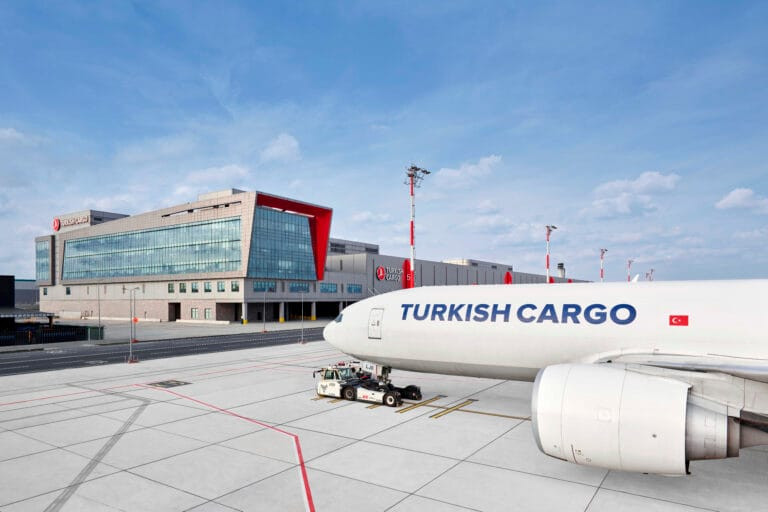When Turkish Cargo set out to double its handling capacity and automate its Istanbul hub, it was not just responding to growth. It was signalling a strategic intent: to lead the next phase of global airfreight through intelligent infrastructure, data-led logistics, and precision automation. That ambition is now taking shape under the banner of SMARTIST 2.0.
The expansion of Turkish Cargo’s next-generation hub is more than a capacity upgrade. “SMARTIST 2.0 represents a pivotal step in our digital transformation roadmap,” said Ali Türk, Chief Cargo Officer at Turkish Airlines. “With its design phase underway, this expansion will double our handling capacity and elevate our automation capabilities to new levels.”
SMARTIST, which currently handles 2.2 million tonnes annually, is being scaled to 4.5 million tonnes. But the volume alone does not define the project’s significance. As Türk explained, the new phase includes the deployment of a next-generation automated storage and retrieval system (ASRS), expanded use of unmanned ground vehicles (UGVs), and the introduction of a fully integrated warehouse management platform.
“We are significantly increasing temperature-controlled zones to support pharma logistics,” he added. “And deploying AI-powered systems for real-time tracking, dynamic load planning, and anomaly detection.” These technologies are not being bolted-on—they are embedded at the core of operations. Türk described this as a deliberate move to “enhance throughput, precision, and service diversification”, positioning SMARTIST among the world’s most advanced cargo hubs.
How automation shapes the flow
At the operational level, automation is central to how Turkish Cargo executes speed and safety at scale. “Our ASRS manages over 17,000 pallet positions via 30 autonomous stacker cranes,” Türk said. The system enables seamless storage and retrieval, allowing faster turnaround and minimising human error.
Equally notable is the ULD storage system, which includes 2,000 positions, 200 of which are temperature-controlled. “It assigns slots automatically based on cargo type and sensitivity,” Türk explained.
This dynamic allocation system integrates with robotic process automation (RPA) tools that optimise task routing and resource management in real time. Autonomous mobile robots (AMRs) are also being piloted for internal cargo movement, adding a further layer of efficiency and safety to operations.
The intent, according to Türk, is clear: “These technologies work together to improve safety, increase operational speed, and ensure end-to-end traceability.”
The role of data in cargo performance
Technology at SMARTIST is not just about machinery—it is also about information. Türk detailed how the facility uses real-time cargo tracking, automated acceptance systems, and intelligent scanning tools supported by AI. These systems optimise load balancing, predict cargo flow, and detect operational anomalies before they escalate.
Internally, the CAPRON platform and ULD contour reporting—developed in-house with Turkish Technology—enable more precise apron coordination and performance monitoring. “Digitalisation is central to how we operate and innovate,” Türk emphasised.
In sensitive verticals such as pharmaceuticals, IoT sensors play a crucial role. “We apply sensors to monitor temperature, humidity, and location in real time,” he said, ensuring compliance and quality across the entire supply chain. While blockchain remains under evaluation, Türk was pragmatic: “We prioritise technologies that offer practical value, scalability, and transparency.”
Cool chain
Pharmaceutical logistics is not a secondary focus—it is structurally embedded within SMARTIST’s expansion. The facility houses a dedicated temperature-controlled centre (TCC), designed to meet international standards and support the company’s pharma vertical, TK Pharma.
“We hold CEIV Pharma and GDP certifications,” said Türk, adding that SMARTIST is built to handle all tiers of pharma handling, from passive storage to active container management.
TK Pharma services are offered at three levels: Standard (dedicated handling and storage), Extra (24/7 monitoring and tarmac dollies), and Advanced (active container solutions for sensitive temperature ranges from –70°C to +30°C). Each tier is supported by trained teams, continuous audits, and data-driven visibility tools.
“With the expansion under SMARTIST 2.0, we are doubling our cold chain capacity,” Türk said. That move aligns with Turkish Cargo’s broader aim of becoming a leading global player in healthcare logistics.
Behind the investment in automation lies a deeper strategic philosophy. “We continue to develop our workforce through training, performance culture, and cross-functional collaboration,” Türk said. The human and digital elements are not in competition—they are complementary. This balance is particularly critical in a volatile global market.
The pandemic, geopolitical shocks, and shifting trade routes have forced carriers to become more adaptive. Türk reflected on this operational philosophy: “Whether navigating pandemic disruptions, shifting trade flows, or geopolitical tensions, Turkish Cargo has responded with agility and speed.”
From operating over 7,000 cargo-only flights during the pandemic to building a “global medical corridor”, the carrier has shown its capacity for rapid redeployment of assets. “This flexibility continues today through scenario-based planning, dynamic capacity management, and strong execution on the ground,” he added.
SMARTIST is not just a flagship hub. It is becoming a prototype for how digital infrastructure, automation, and cargo specialisation can converge in a single, adaptive system. This is logistics not just at scale, but at speed and precision—qualities that are rapidly becoming non-negotiable in the airfreight sector.
The ambition, according to Türk, is to lead not only in capacity, but in agility, innovation, and reliability. That means investing in technologies that scale, in infrastructure that adapts, and in people who can work with both.
As the facility evolves, so too will its role in shaping how carriers think about performance. It is no longer enough to move fast. In Türk’s view, the future belongs to those who move fast and know exactly why, where, and how—before the shipment even arrives.



